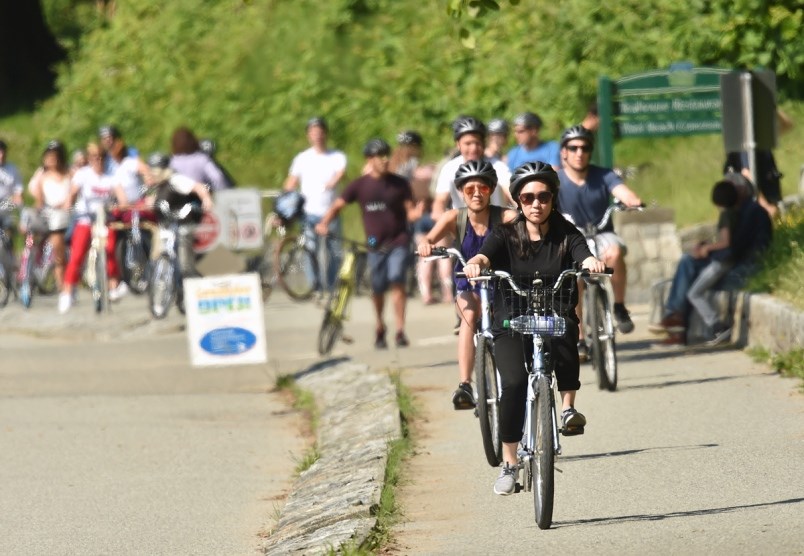Dave Hutch, the park board’s director of planning and park development, said Monday the bike lane will be separated by a barrier along the two-lane Stanley Park Drive, which was closed to vehicle traffic in early April.
Hutch said motorists will be able to pass slower vehicles at wider sections of the road and continue to access parking lots and make turns at intersections. The park was closed to vehicles April 8 to create more space on the park’s seawall for physical distancing and move cyclists to the park’s main road.
“This is a temporary measure and it’s aimed at the busy local summer season to provide the space and more opportunity for the health, wellness and social connectedness,” Hutch told park board commissioners of the new bike lane.
“I want to ensure the board that we are talking weeks in terms of the timeline to get vehicle access into the park, but there are a number of challenges to overcome in ensuring a safe and laned approach.”
Hutch noted those changes could include cyclists using a portion of the seawall.
Though temporary, the separated bike lane could be what the park board ultimately includes in a future permanent traffic plan for the park. Commissioners voted 5-2 Monday to have staff explore the long-term feasibility of reducing vehicle traffic in Stanley Park.
Comm. John Irwin successfully moved the motion, with support from commissioners Dave Demers, Gwen Giesbrecht, Stuart Mackinnon and Camil Dumont. Irwin focused on the potential environmental gains in the park, noting 30 per cent of the city’s greenhouse gas emissions are generated from vehicles.
“We feel that convenient transportation alternatives such as electric shuttle buses, increased bike share hubs, bicycle rickshaws, etcetera, could greatly reduce vehicle trips to Stanley Park,” he said, noting he recently urged the mayors’ council on regional transportation to examine whether creating more bus access to the park along the causeway was feasible, along with a possible return of the B.C. Transit route around the park.
NPA commissioners Tricia Barker and John Coupar said the motion was too prescriptive and noted 6,000 people signed a petition with concerns about future access to the park by seniors and others with mobility challenges.
Business operators in the park have also raised concerns about the effect reducing traffic would have on their restaurants, cafes and other attractions.
Barker tried unsuccessfully to refer the motion to a committee meeting for more discussion.
“Over the last week, we’ve heard from a great many people very interested in this subject,” she said, pointing out city advisory committees representing seniors and persons with disabilities want more time to discuss the issue.
“We’re under a lockdown, and so people haven’t been able to come out and speak to this or about anything going on in their lives. And now this is happening and they don’t have the opportunity to speak to something that would very much affect their lives.”
Coupar said the motion “presupposes the outcome” of reducing traffic in the park.
“Once we decide on this tonight, we’re sending direction to staff to say, ‘We want you to reduce traffic in Stanley Park,’” he said.
Irwin’s motion requests staff consult with a variety of groups, including persons with disabilities and mobility challenges, along with “park partners, stakeholders, and the community at large” before a report returns to the board.
Giesbrecht said not everyone “has the luxury of a private automobile” to drive through the park and some people don’t have the ability to walk on the seawall, never mind navigate around bicycles on the path.
“The beauty of Stanley Park should be available to each and every one of the people who live in Vancouver,” she said.
“In no way is this a discussion about eliminating cars in Stanley Park. This is about reducing some of the motor vehicle traffic in Stanley Park.”
MacKinnon said change is difficult, noting when one-way streets were introduced in the city, some people thought traffic would grind to a halt. Same goes for traffic-calming measures when some people thought they wouldn’t be able to access their neighbourhood, he said.
“People generally don’t like change, but as we reopen our parks and recreation facilities, I believe this is a good time to examine our policies on accessibility,” Mackinnon said.
“Despite what you may have heard or read, this motion is not asking for a ban on cars in Stanley Park. On the contrary, automobile access to the park is just one of many ways individuals and groups access the park and must be able to continue to do so.”
However, he said, as the park has become more popular, it was now time to review who has access. He emphasized the motion requests staff to consider the feasibility of reducing traffic, not proceeding with a plan to reduce it.
“They may come back with recommendations to pedestrians or bicycle access, they may come back with recommendations that automobile access be changed, they may recommend improved public transit within the park, they may recommend something else completely, or they may conclude saying no changes are necessary at all,” Mackinnon said.
The board, meanwhile, heard that staff continues to work on implementing this summer for people to be able to at select beaches and parks. No date for implementation was provided.
@Howellings



